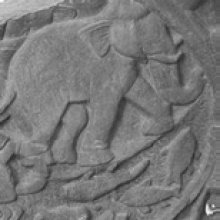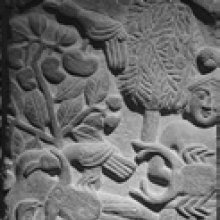Crab: 1 definition
Introduction:
Crab means something in Hinduism, Sanskrit. If you want to know the exact meaning, history, etymology or English translation of this term then check out the descriptions on this page. Add your comment or reference to a book if you want to contribute to this summary article.
Images (photo gallery)
In Hinduism
Natyashastra (theatrics and dramaturgy)
Source: Shodhganga: Elements of Art and Architecture in the Trtiyakhanda of the Visnudharmottarapurana (natya)The Crab (animal) is denoted by the Sanskrit term Kulira or Karkaṭa, whereas Karkaṭahasta refers to one of the thirteen Combined-hand Gestures (in Indian Dramas) (known as saṃyuktahastas), according to the Viṣṇudharmottarapurāṇa, an ancient Sanskrit text which (being encyclopedic in nature) deals with a variety of cultural topics such as arts, architecture, music, grammar and astronomy.—According to the Śabdakalpadruma, karkaṭa means kulira i.e., crab. In karkaṭahasta, fingers are passed between the fingers of both hands together and it makes the shape of a crab. This posture is used while yawning. According to Abhinayadarpaṇa, this karkaṭa-hasta is used to denote coming of a crowd, showing the stomach, filling the conch-shell, twisting limbs, pulling branch etc.

Natyashastra (नाट्यशास्त्र, nāṭyaśāstra) refers to both the ancient Indian tradition (shastra) of performing arts, (natya—theatrics, drama, dance, music), as well as the name of a Sanskrit work dealing with these subjects. It also teaches the rules for composing Dramatic plays (nataka), construction and performance of Theater, and Poetic works (kavya).
See also (Relevant definitions)
Starts with: Crab bone, Crab bush, Crab grass, Crab wood, Crab-eye vine, Crabapple mangrove, Crabbea velutina, Crabgrass, Crabwood.
Ends with: Crab bone, Pond crab.
Full-text (+243): Kulira, Karkataka, Karkata, Pingacakshus, Harilocana, Apatyashatru, Kulirad, Kuliraka, Vahishcara, Mukhastra, Maghama, Sadamshaka, Mrityusuti, Parshvodarapriya, Karka, Kuracilla, Pankavasa, Shodashanghri, Vahihkuticara, Kakkatakarasa.
Relevant text
Search found 69 books and stories containing Crab; (plurals include: Crabs). You can also click to the full overview containing English textual excerpts. Below are direct links for the most relevant articles:
Village Folk-tales of Ceylon (Sri Lanka), vol. 1-3 (by Henry Parker)
Story 75 - The Crocodile And The Jackal < [Part II (e) - Stories of the Kinnaras]
Story 64 - The Heron And The Crab < [Part II (c) - Stories of the Durayas]
Story 29 - The Pied Robin < [Part I - Stories told by the Cultivating Caste and Vaeddas]
Significance of the Moon in Ancient Civilizations (by Radhakrishnan. P)
12. Symbolic Crab and Moon < [Chapter 7 - Moon the Significant Planet of Mind]
3. Lunar Effects and Natural Astrology < [Chapter 15 - Conclusion]
12. Astrologial overview on Moon in Zodiac Signs < [Chapter 5 - Adoration of the Sun and Moon]
Ten Little Vignettes < [August 1948]
Two poems < [May-June 1931]
Sanskrit Limericks < [October-December 1942]
The Jataka tales [English], Volume 1-6 (by Robert Chalmers)
Jataka 389: Suvaṇṇakakkaṭa-jātaka < [Volume 3]
Jataka 267: Kakkatā-jātaka < [Book III - Tika-Nipāta]
Jataka 38: Baka-jātaka < [Book I - Ekanipāta]
Amarakoshodghatana of Kshirasvamin (study) (by A. Yamuna Devi)
Fauna (7): Aquatic Animals < [Chapter 5 - Aspects of Nature]
Folklore of the Santal Parganas
Chapter CVI - The Speaking Crab < [Part I]
Chapter XCI - Another Lazy Man < [Part I]
Chapter LVII - The Raja’s Advice < [Part I]
Related products





